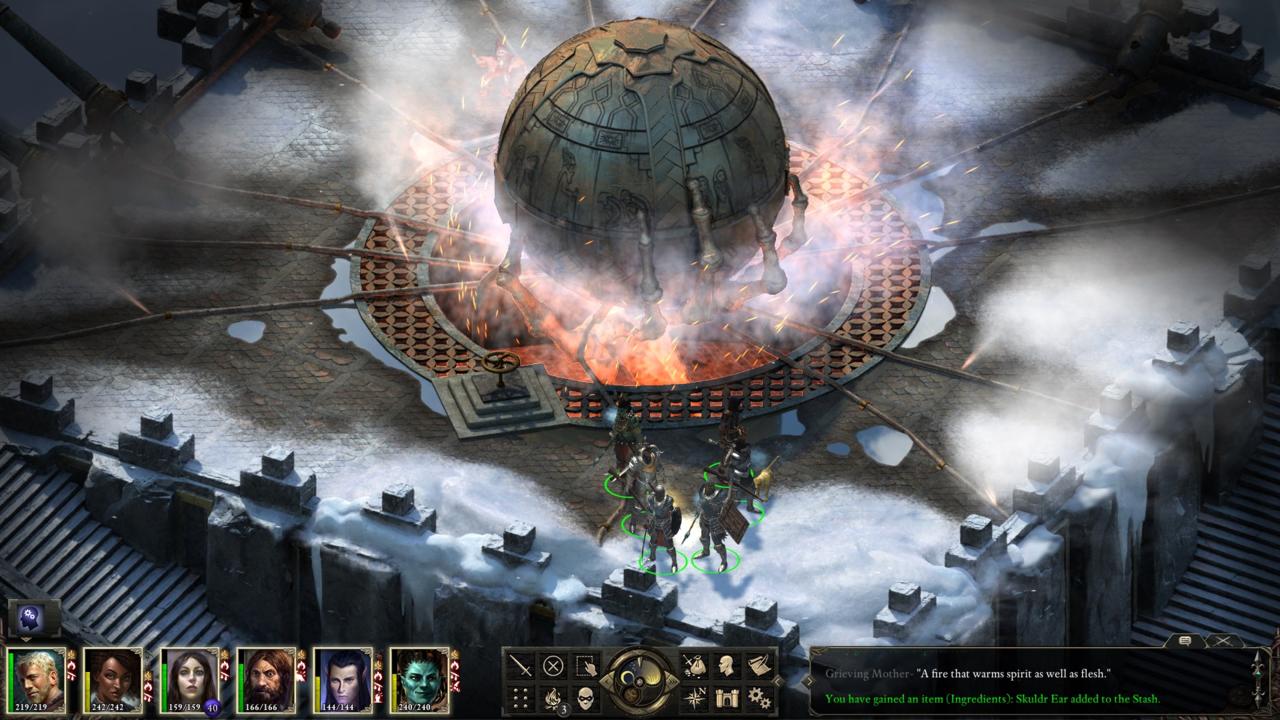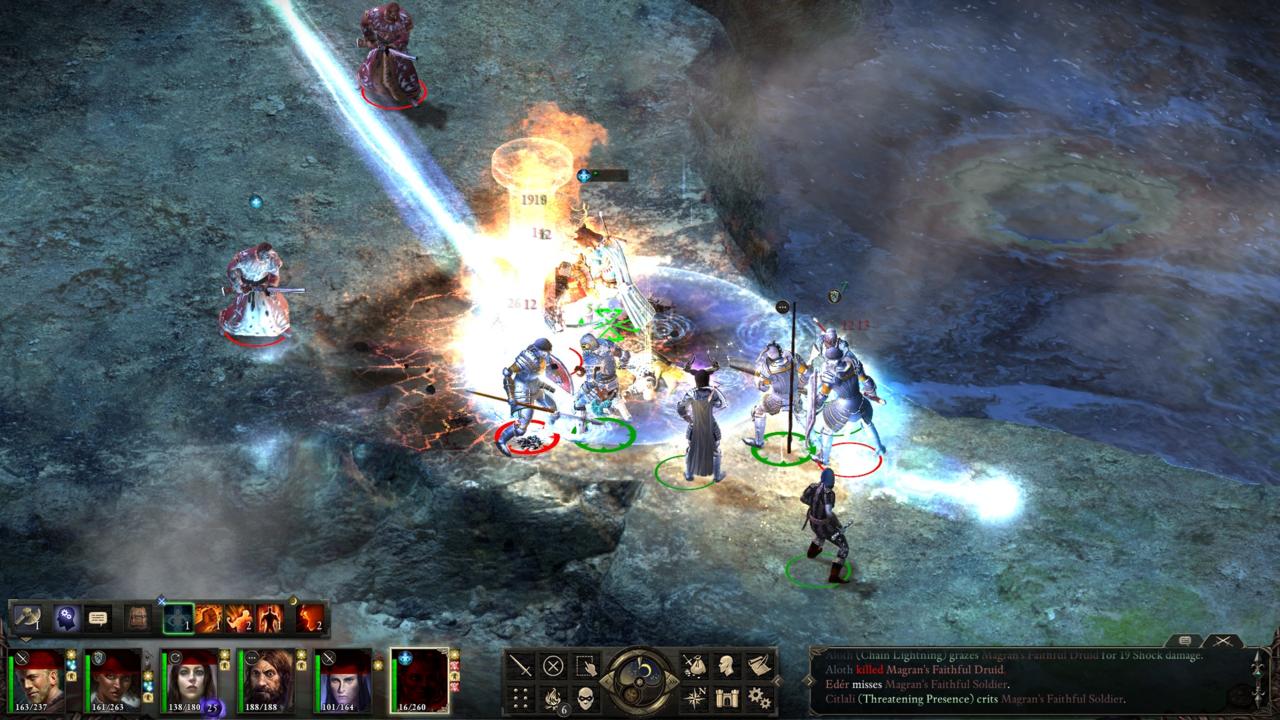Pillars of Eternity comes to an end in The White March Part 2. This second chapter to what will apparently be the only expansion for Obsidian’s epic RPG resolves a couple dangling plot threads and tacks on a cataclysmic conclusion that ties into the greater mythology of the world of Eora. But while the add-on works by providing the apocalyptic story players expect, it fails due to heavy, dreary combat, a main storyline that runs on rails, and the absence of many little things that tend to make RPGs memorable.
As expected, The White March Part 2 picks up right after its predecessor ended. Rest once outside of the White March district on your map and the action begins with an ominous dream about the entire area being wiped out by an invading army. Head back up to the town of Stalwart and you discover that this dream may be something of a prophecy: an actual army under the name of the Iron Flail is encamped outside the ancient Durgan’s Battery fortress with a plan to seize the mystical White Forge for their own sinister purposes.
But all that sounds better than it actually plays. Your trials begin by going over old ground in Durgan’s Battery and the Stalwart mines. The Battery’s cannons need to be fired up to help against the inevitable attack from the enemy army, and the mines are being plagued by some kind of mysterious plague that is turning men into crazed killers. Both quests are fairly enjoyable, although it is more than a bit disappointing to start this new expansion by heading right back to places that you already apparently scoured of villainy.
There aren't many new features outside of the story to draw you in, either. The hub for all of your northern activities remains Stalwart, which looks pretty much the same as it did before. Just a few side quests are offered, mostly uninteresting fare like searching for a runaway little girl and killing a few more outlaws for bounties, along with some stronghold assignments that world-build while you’re dungeon delving. The level cap has been bumped up to 16 from the previous 14. Both the menu and skill systems have been slightly tweaked, although not in any headlining fashion. The only new party member here is a barbarian named Meneha, whose bleak past is oddly matched with the voice of a hillbilly housewife. Her backstory and personal quest ties nicely into the main plot, although she’s only in for the ride, as you both wind up having to visit the Abbey of the Fallen Moon, site of some interesting happenings in the far-distant past.

That main plot leading to the abbey is pretty intriguing. The first part of The White March focused on the local story of Stalwart and the isolated dungeon of Durgan’s Battery, but this second part goes all-out. It is a tale of the gods, towering automaton enemies called Eyeless that seem to have been pulled right out of old Thor comics, and--surprise--the potential end of the world. Art in the new locations matches this larger-than-life feel, too. The abbey is a haunting ancient ruin, like something you might see if you had a time machine and a hankering to visit Crete. And the poignant music interplays with everything to make for some truly memorable moments.
As with the first part of The White March, the second hammers you with battle after battle. Even worse, you face the same collection of foes over and over again in each section of the map.
Still, the plot becomes a negative because the game places too much emphasis on it. The preamble side quests and bounty tasks can be wrapped in just a few hours. Then you charge right into the main quest and stay there for another seven or eight hours until the conclusion of the game. Everything is a little too relentless, with the story pushing you forward on a one-way track rather than opening up and drawing you in. There's too little time to take in the world and events on your own terms, be it by engaging in optional chit-chat with NPCs or by venturing off the beaten path in search of unexpected surprises.
Another significant drawback is the preponderance of combat. As with the first part of The White March, the second hammers you with battle after battle. Even worse, you face the same collection of foes over and over again in each section of the map. As the game plods on, though, repetition and monotony take over. When storming back into Durgan’s Battery, you duke it out with nearly identical mobs of Skuldrak. When in the mines, you face a succession of nearly identical mobs of Radiant Sporelings and Vithrack. When in the abbey, you face off with nearly identical mobs of monks and warriors. And so on.

There isn’t much imaginative game design on display here, and many of common fights are overly difficult. You can get wiped out a few times by random gangs of goons, then steel yourself for an epic boss and wind up flying through it in a single try. As a result, combat gets rather annoying and regularly drags the game down. Everything is pretty chaotic, too, with it being very tough to track which character is which when massed together in melee combat with the foes in the aforementioned mobs.
By the time The White March Part 2 wraps up, you will probably be ready to say farewell to Pillars of Eternity.
One saving grace is the new Story Mode difficulty setting. This option is even easier than Easy, to the point where you can pretty much zip through fights on auto-pilot. Granted, this isn’t an ideal solution as it removes the challenge of the game almost entirely. But it is still a good way to skip past the drudgery of the constant scraps with duplicate foes, especially if you just want to see how the White March saga ends.
By the time The White March Part 2 wraps up, you will probably be ready to say farewell to Pillars of Eternity. While this is undoubtedly a great RPG franchise, both parts of this expansion feel more like leftovers bulked up with unnecessary combat than anything really crucial to the overall experience provided in the core game. Too much emphasis on battles and too tight a focus on the main story--as interesting as it can be at times, especially if you’re interested in the mythology of Eora--makes the game something of a forced march that removes the wonder of exploring an open world.